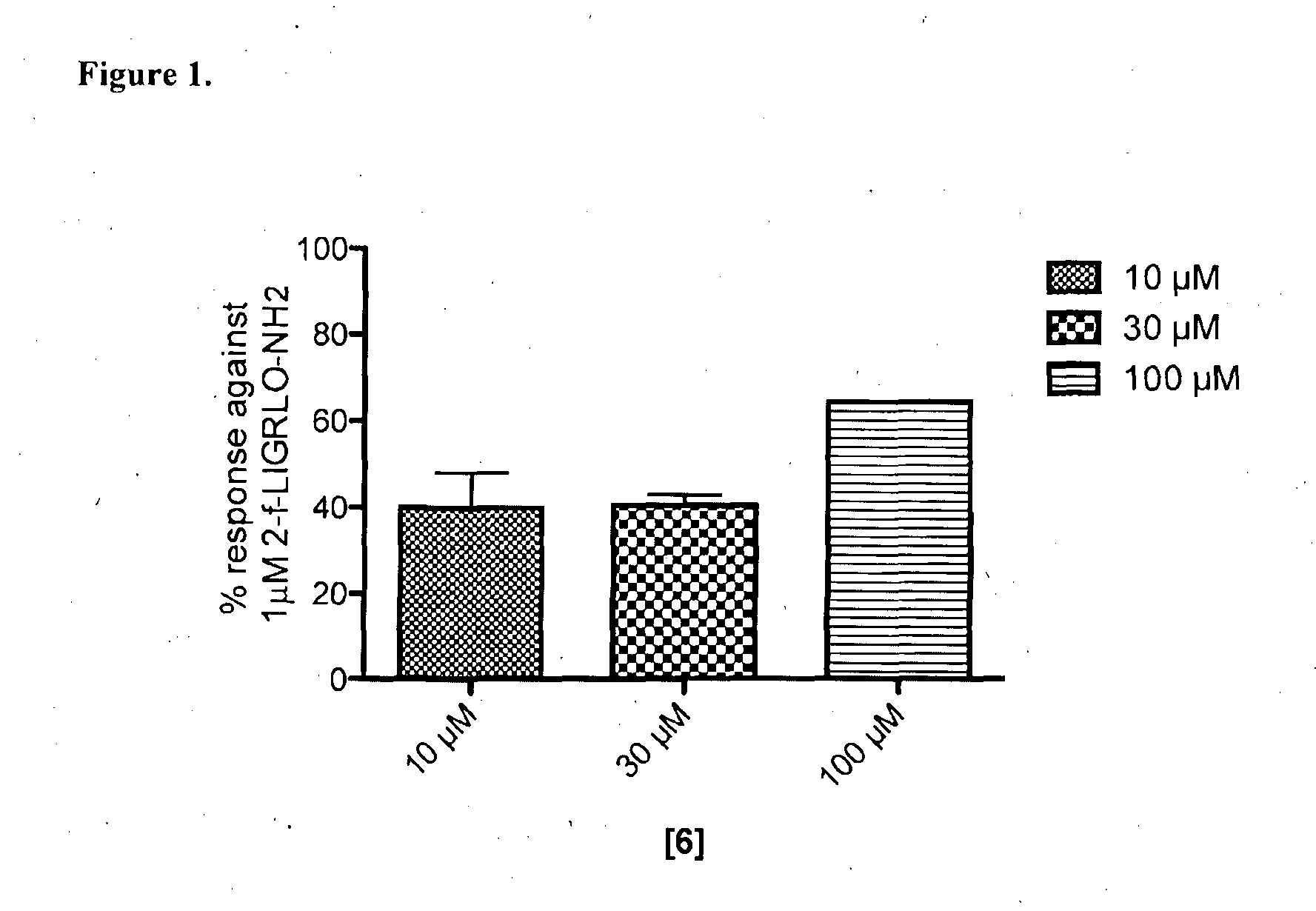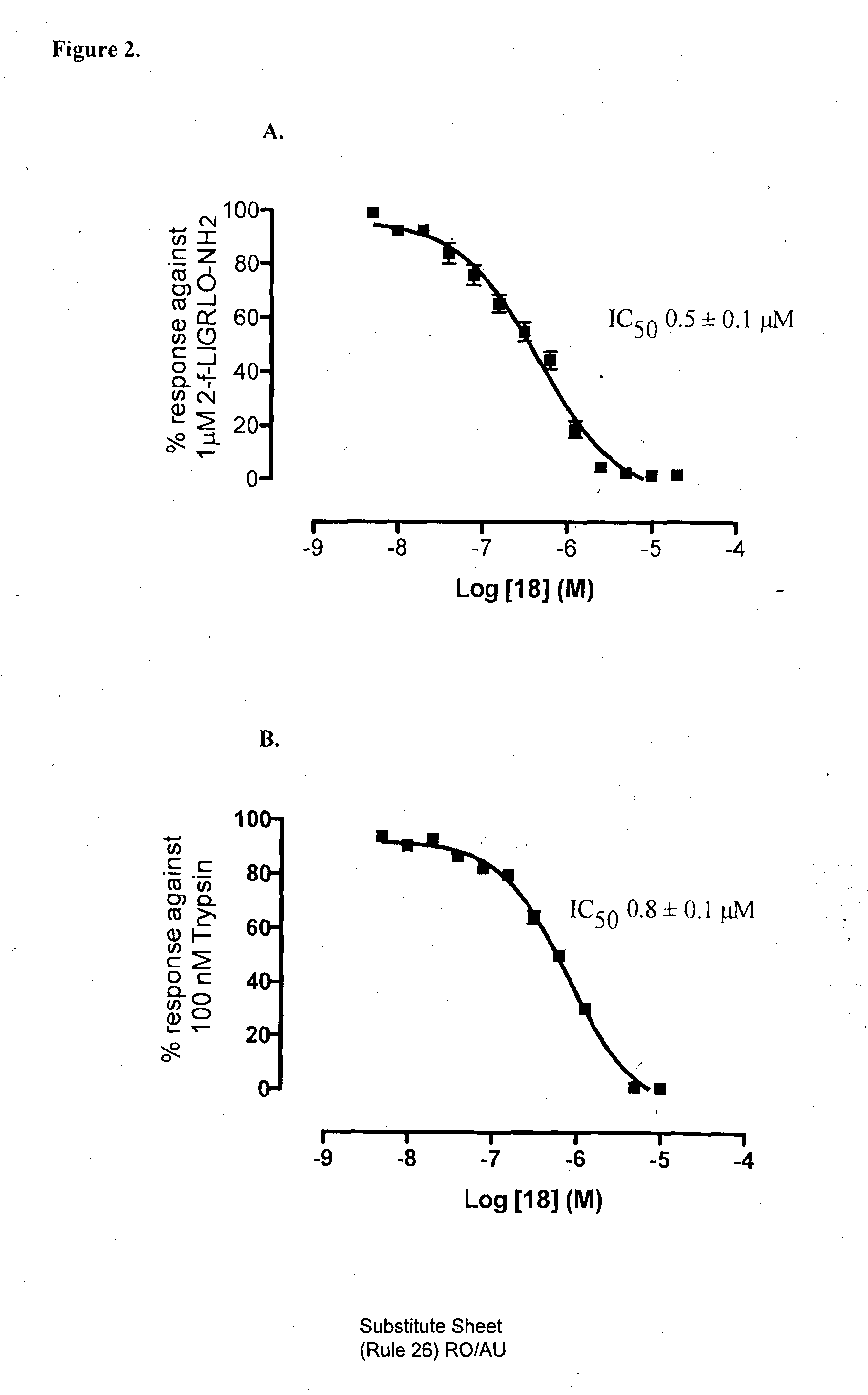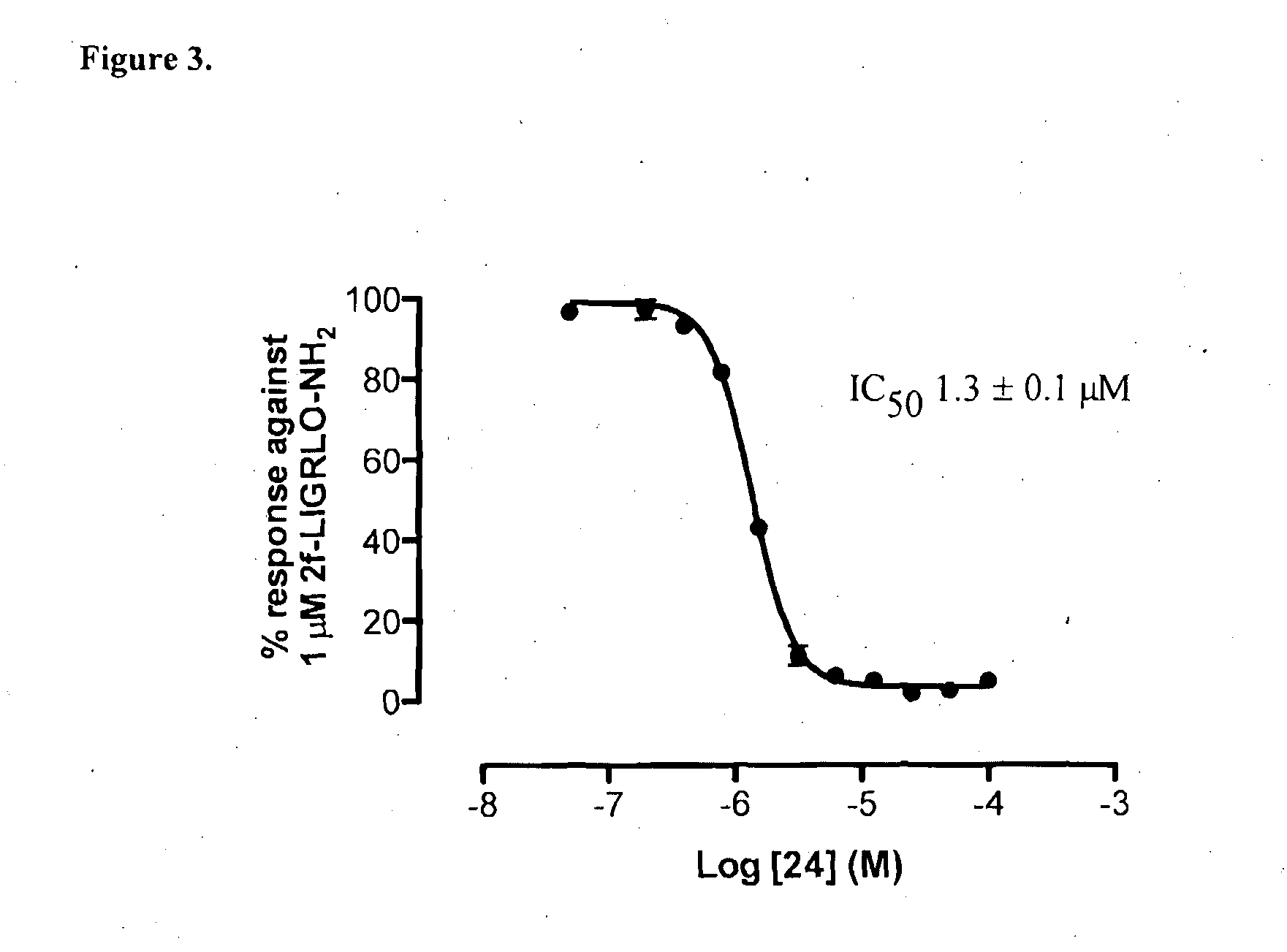Modulators of protease activated receptors
a protease activator and receptor technology, applied in the field of compounds capable of modulating protease activator receptors, can solve the problems of obesity, metabolic dysfunction and impaired immunity, and achieve the effects of reducing the risk of obesity
- Summary
- Abstract
- Description
- Claims
- Application Information
AI Technical Summary
Benefits of technology
Problems solved by technology
Method used
Image
Examples
example 1
Preparation of 5-isoxazoyl-Cha-Ile-aminomethyl-(2-fluorophenyl (6)
[0281]
[0282]Compound 6 was synthesised by following the general amino acid coupling procedure A.
[0283]1H NMR (400 MHz, CDCl3): δ 0.79-0.86 (m, 8 II), 0.88-0.98 (m, 1H), 1.01-1.23 (m, 5H), 1.27-1.37 (m, 1H), 1.39-1.49 (m, 1H), 1.63-1.77 (H's overlap with H2O peak), 1.81-1.88 (m, 1H), 4.40-4.45 (dd, 1H, J=5.6, 14.8 Hz), 4.51-4.57 (dd, 1H, J=6.0, 14.8 Hz), 4.70-4.76 (m, 1H), 6.63 (br s, 1H), 6.87-6.89 (br s, 1H), 6.91-6.92 (d, 1H, J=2 Hz), 7.00-7.10 (m, 2H), 7.22-7.36 (m, 3H), 8.30-8.31 (d, 1H, J=1.6 Hz).
[0284]HRMS: [MH]+ 487.2715 (calc. for C26H36FN4O4+) 487.2718 (found).
example 2
Preparation of 5-isoxazoyl-Cha-Ile-aminomethyl-(2-methoxy)phenyl (18)
[0285]
[0286]Compound 18 was synthesised by following the general amino acid coupling procedure A.
[0287]1H NMR (400 MHz, CDCl2): δ 0.82-0.86 (m, 7H), 0.88-1.00 (m, 2H), 1.04-1.22 (m, 1H), 1.25-1.37 (m, 2H), 1.40-1.46 (m, 1H), 1.59-1.73 (m, 7H), 1.77-1.84 (m, 2H), 3.86 (s, 3H), 4.19-4.23 (dd, 1H, J=6.8, 8.8 Hz), 4.37-4.42 (dd, 1H, J=6, 14.4 Hz), 4.46-4.51 (dd, 1H, J=6, 14.4 Hz), 4.60-4.65 (m, 1H), 6.19-6.21 (t, 1H, J=5.6 Hz), 6.50-6.53 (d, 1H, J=8.8 Hz), 6.87-6.93 (m, 3H), 6.99-7.01 (d, 1H, J=7.2 Hz), 7.23-7.29 (m, 2H), 8.331-8.335 (d, 1H, J=1.6 Hz).
[0288]HRMS: [MH]+ 499.2915 (calc. for C27H39N4O5+) 499.2915 (found)
example 3
Preparation of 5-isoxazoyl-Cha-Ile-aminomethyl-(2-isopropoxy)phenyl (24)
[0289]
[0290]Step a: In a microwave reaction vial was loaded salicylaldehyde eq), DMF, DBU (1 eq) and the corresponding 2-iodopropane. The vessel was sealed and the mixture was irradiated in Biotage Initiator microwave reactor (140° C., 10 min). The progress of the reaction was monitored by TLC (PE / EtOAc 4:1, product Rf ˜0.5). Upon completion, the reaction mixture was allowed to cool down, diluted with EtOAc and washed with sat. Na2CO2 (3×) to remove starting material salicylaldehyde. The organic phase was dried over MgSO4, filtered and evaporated to dryness to the give product as a yellow liquid (70% yield), which was used without further purification.
[0291]Step b: The resulting aldehyde was treated with hydroxylamine hydrochloride (2 eq.) and NaOH (4 eq.) in MeOH / H2O (1:1) and stirred at room temperature for an hour. After completion, the reaction solution was evaporated to dryness and then re-dissolved in EtOA...
PUM
| Property | Measurement | Unit |
|---|---|---|
| emission wavelength | aaaaa | aaaaa |
| emission wavelength | aaaaa | aaaaa |
| excitation wavelength | aaaaa | aaaaa |
Abstract
Description
Claims
Application Information
 Login to View More
Login to View More - R&D
- Intellectual Property
- Life Sciences
- Materials
- Tech Scout
- Unparalleled Data Quality
- Higher Quality Content
- 60% Fewer Hallucinations
Browse by: Latest US Patents, China's latest patents, Technical Efficacy Thesaurus, Application Domain, Technology Topic, Popular Technical Reports.
© 2025 PatSnap. All rights reserved.Legal|Privacy policy|Modern Slavery Act Transparency Statement|Sitemap|About US| Contact US: help@patsnap.com



